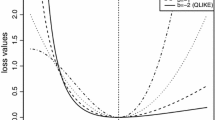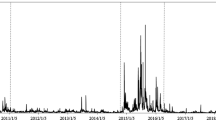Abstract
The availability of ultra-high-frequency data has sparked enormous parametric and nonparametric volatility estimators in financial time series analysis. However, some high-frequency volatility estimators are suffering from biasness issues due to the abrupt jumps and microstructure effect that often observed in nowadays global financial markets. Hence, we motivate our studies with two long-memory time series models using various high-frequency multipower variation volatility proxies. The forecast evaluations are illustrated using the S&P500 data over the period from year 2008 to 2013. Our empirical studies found that higher-power variation volatility proxies provide better in-sample and out-of-sample performances as compared to the widely used realized volatility and fractionally integrated ARCH models. Finally, these empirical findings are used to estimate the one-day-ahead value-at-risk of S&P500.






Similar content being viewed by others
Notes
Seasonality often exists in high-frequency intraday return, however, not for the intraday quadratic variation. To the authors’ best knowledge, there are two important literatures Taylor and Xu (1997) and Martens et al. (2002) dealing with seasonality in high-frequency intraday return. For better forecasts, Taylor and Xu (1997) suggested to use variance multiplier to deseasonalize the intraday return (one-minute data) for FOREX in a GARCH-based model. Similar approached had been implemented by Martens et al. (2002) in spot FOREX (hourly data) of the Deutsche mark and the Japanese yen against the US dollar. From the authors point of views, since the GARCH model specifications consist of conditional mean (return) and conditional volatility equations, the intraday returns have direct impact to the volatility estimation accuracy. However, for high-frequency volatility models such as HAR and ARFIMA, these models directly using the realized volatility (or other power variation volatility) which have no direct influences from the intraday return.
Other than GARCH-based models, Deo et al. (2006) proposed a slow time-varying seasonal intraday return filtration (hourly data) for the US stock market using stochastic volatility model. Ghysels et al. (2006) suggested mix data sampling (MIDAS) regression approach with the consideration of seasonal adjustment in S&P500 index empirical analysis. As a summary, the intraday return seasonality filtration can be considered as a special topic which needs a careful study in terms of their theoretical properties. Thus, the authors only have intension to include this feature in our future study.
References
Andersen TG, Bollerslev T (1997) Intraday periodicity and volatility persistence in financial markets. J Empir Finance 4:115–158
Andersen TG, Bollerslev T (1998) Answering the skeptics: yes, standard volatility models do provide accurate forecasts. Int Econ Rev 39:885–906
Andersen TG, Bollerslev T, Diebold FX (2007) Roughing it up: including jump components in the measurement, modeling and forecasting of return volatility. Rev Econ Stat 89:701–720
Andersen TG, Bollerslev T, Diebold FX, Labys P (2000) Great realizations. Risk Mag 13:105–108
Andersen TG, Bollerslev T, Diebold FX, Labys P (2001) The distribution of realized exchange rate volatility. J Am Stat Assoc 96:42–55
Andersen TG, Bollerslev T, Diebold FX, Labys P (2003) Modelling and forecasting realized volatility. Econometrica 71:579–625
Andersen TG, Bollerslev T, Meddahi N (2005) Correcting the errors: volatility forecast evaluation using high-frequency data and realized volatilities. Econometrica 73:279–296
Andersen TG, Bollerslev T, Meddahi N (2011) Realized volatility forecasting and market microstructure noise. J Econom 160:220–234
Andersen TG, Dobrev D, Schaumburg E (2012) Jump-robust volatility estimation using nearest neighbor truncation. J Econom 169:75–93
Angelidis T, Degiannakis S (2008) Volatility forecasting: intra-day versus inter-day models. J Int Financ Mark Inst Money 18:449–465
Baillie RT, Bollerslev T, Mikkelsen HO (1996) Fractionally integrated generalized autoregressive conditional heteroskedasticity. J Econom 74:3–30
Bandi FM, Russell JR (2008) Microstructure noise, realized volatility, and optimal sampling. Rev Econ Stud 75:339–369
Barndorff-Nielsen OE, Shephard N (2002) Estimating quadratic variation using realised volatility. J Appl Econom 17:457–477
Barndorff-Nielsen OE, Shephard N (2004) Power and bipower variation with stochastic volatility and jumps. J Financ Econom 2:1–37
Barndorff-Nielsen OE, Graversen SE, Jacod J, Podolskij M, Shephard N (2006) A central limit theorem for realised power and bipower variations of continuous semi-martingales. In: Kabanov Y, Liptser R, Stoyanov J (eds) From stochastic calculus to mathematical finance. Festschrift in Honour of A.N. Shiryaev, vol 2. Springer, Heidelberg, pp 33–68
Bollerslev T, Ghysels E (1996) Periodic autoregressive conditional heteroscedasticity. J Bus Econ 14:139–151
Chai T, Draxler RR (2014) Root mean square error (RMSE) or mean absolute error (MAE)? Arguments against avoiding RMSE in the literature. Geosci Model Dev 7:1247–1250
Cheong CW, Isa Z, Nor AHSM (2007) Modeling financial observable-volatility using long memory models. Appl Financ Econ Lett 3:201–208
Cheong CW (2013) The computational of stock market volatility from the perspective of heterogeneous market hypothesis. J Econ Comput Econ Cybern Stud Res 47:247–260
Chin WC, Lee MC, Tan PP (2016) Heterogeneous market hypothesis evaluation using multipower variation volatility. Commun Stat Simul Comput. https://doi.org/10.1080/03610918.2016.1208234
Chin WC, Isa Z, Tan PP, Lee MC (2015) The computation of high frequency S&P500 long-range dependence volatility using dynamic modified rescaled adjusted range approach. Appl Math Sci 9:5915–5924
Christoffersen P (1998) Evaluating interval forecasts. Int Econ Rev 39:841–862
Cont R (2001) Empirical properties of asset returns: stylized facts and statistical issues. Quant Finance 1:223–236
Corsi F, Mittnik S, Pigorsch C, Pigorsch U (2008) The volatility of realized volatility. Econom Rev 27:46–78
Corsi F (2009) A simple approximate long memory model of realized volatility. J Financ Econom 7:174–196
Corsi F, Pirino D, Renò R (2010) Threshold bipower variation and the impact of jumps on volatility forecasting. J Econom 159:276–288
Dacorogna MM, Mller U, Olsen R, Pictet OV (2001) Defining efficiency in heterogeneous markets. Quant Finance 198–201
Davidson J (2004) Moment and memory properties of linear conditional heteroskedasticity models, and a new model. J Bus Econ Stat 22:16–29
Degiannakis S, Christos F (2013) Modeling CAC40 volatility using ultra-high frequency data. Res Int Bus Finance 28:68–81
Deo R, Hurvich C, Lu Y (2006) Forecasting realized volatility using a long-memory stochastic volatility model: estimation, prediction and seasonal adjustment. J Econom 131:29–58
Diebold FX, Mariano RS (1995) Comparing predictive accuracy. J Bus Econ Stat 13:253–263
Engle R (2002) Dynamic conditional correlation: a simple class of multivariate generalized autoregressive conditional heteroskedasticity models. J Bus Stat 20:339–350
Engle R, Manganelli S (2004) Caviar: conditional autoregressive value at risk by regression quantiles. J Bus Econ Stat 22:367–381
Fama EF (1998) Market efficiency, long-term returns, and behavioral finance. J Financ Econ 49:283–306
Ghysels E, Sinko A, Valkanov R (2006) MIDAS regressions: further results and new directions. Econometric 26:53–90
Hansen PR, Lunde A (2006) Realized variance and market microstructure noise. J Bus Econ Stat 24:127–218
Hong Y, Li H, Zhao F (2004) Out-of-sample performance of discrete-time spot interest rate models. J Bus Econ Stat 22:457–473
Jorion P (2006) Value-at-risk: the new benchmark for controlling market risk, 3rd edn. McGraw-Hill, Chicago
Koopman SJ, Jungbacker B, Hol E (2005) Forecasting daily variability of the S&P 100 stock index using historical, realised and implied volatility measurements. J Empir Finance 12:445–475
Kupiec P (1995) Techniques for verifying the accuracy of risk management models. J Deriv 3:73–84
Martens M, Chang YC, Taylor S (2002) A comparison of seasonal adjustment methods when forecasting intraday volatility. J Financ Res 25:283–299
Meddahi N (2001) An eigenfunction approach for volatility modeling. Working paper, University of Montreal
Müller UA, Dacorogna MM, Davé RD, Olsen RB, Pictet OV, von Weizsäcker JE (1997) Volatilities of different time resolutions—analysing the dynamics of market components. J Empir Finance 4:213–293
Müller UA, Dacorogna MM, Davé RD, Pictet OV, Olsen RB, Ward JR (1993) Fractals and intrinsic time: a challenge to econometricians. Olsen & Associates, Zrich, Unpublished manuscript
Nelson DB (1991) Conditional heteroskedasticity in asset returns: a new approach. Econometrica 59:347–370
Patton AJ (2011) Volatility forecast comparison using imperfect volatility proxies. J Econom 160:246–256
Peters EE (1994) Fractal market analysis: applying chaos theory to investment and economics. Wiley, Hoboken
Rachev ST (2003) Handbook of heavy tailed distributions in finance: handbooks in finance. Elsevier Science B.V, Amsterdam
Shiller RJ (2008) Historic turning points in real estate. East Econ J 34:1–13
Tan PP, Cheong CW, Galagedera DUA (2014) A wavelet-based evaluation of time-varying long memory of equity markets: a paradigm in crisis. Phys A 410:345–358
Taylor SJ, Xu X (1997) The incremental volatility information in one million foreign exchange quotations. J Empir Finance 4:317–340
Tse YK (1998) The conditional heteroscedasticity of the yendollar exchange rate. J Appl Econom 13:49–55
White H (2000) A reality check for data snooping. Econometrica 68:1097–1126
Acknowledgements
The authors would like to thank the financial support from the Malaysia Ministry of Higher Education (MOHE) under the Fundamental Research Grant Scheme (FRGS) EP160022.
Author information
Authors and Affiliations
Corresponding author
Rights and permissions
About this article
Cite this article
Chin, W.C., Lee, M.C. S&P500 volatility analysis using high-frequency multipower variation volatility proxies. Empir Econ 54, 1297–1318 (2018). https://doi.org/10.1007/s00181-017-1345-z
Received:
Accepted:
Published:
Issue Date:
DOI: https://doi.org/10.1007/s00181-017-1345-z




